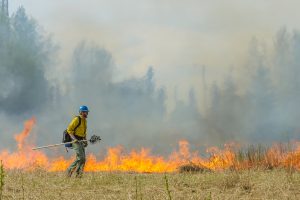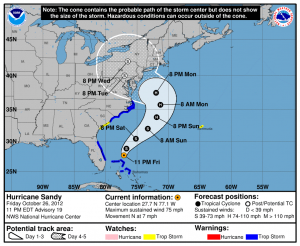Probabilities, Not Promises: How Computer Models are Used in Emergency Preparedness & Response
Posted on by
Computer models are not crystal balls. They are the result of a set of variables going through mathematical algorithms. What comes out is a simulation of what might happen if present truths are accurate predictors of future trends. Models show probabilities; they don’t make promises.
Models have many applications. Epidemiologists use them to predict disease outbreaks. Logisticians use them to estimate supply and demand. Meteorologists use them to forecast the path of severe weather. In most cases, models help officials make informed decisions, including those that affect emergency preparedness and response.
Modeling Wildfires
Wildfires are infamously unpredictable. Subject to the whims of wind and temperature, wildfire behavior, including its causes, consequences, and benefits, is a science unto itself.
One of the methods used to prevent big blazes is called a planned or prescribed fire. Fire managers may “prescribe” a treatment to remove fuels (e.g., grasses, shrubs, and trees) near a developed area, for resource benefits, or for research.

A prescription for a fire spells out the objectives, fuels, size, and environmental conditions for when to burn and when not to burn.
Fire managers are using models to simulate prescribed fires so they can be sure to set the right fire at the right time. FIRETEC is a 3-D simulation program that uses physics to simulate the constantly changing, interactive relationship between fire and the environment. The models simulate factors like vegetation, terrain, airflow, and combustion rates so that fire managers can envision how a controlled burn might play out at a particular time and place. Fighting fire first with imaginary fire is one way modeling can help save lives and prevent property loss.
Forecasting Flu
In 2013, CDC’s Influenza Division began partnering with scientists around the country to use computer modeling in a real-world, flu-forecasting challenge known as FluSight.
Every October through May, teams at universities and labs use models to submit weekly forecasts of how the seasonal flu will progress. Being able to foresee when and where flu increases will occur, how long infection activity might last, and when declines will occur, enables CDC, public-health departments and healthcare providers to anticipate the potential impact on communities around the country.
It’s easy to underestimate the seriousness of flu illness and how disruptive it can be to everyday life. People with flu often miss work, school, or recreational activities. Serious flu illnesses can even result in hospitalization and in some cases death. Flu also has economic impacts on people’s lives and their communities. Flu forecasting provides information that can help people stay healthy and lessen the impact of the disease.
Modeling the Blood Supply
Just like with consumer goods, there is a supply and demand system for donated blood. When emergencies create shortages in an area of the country, blood must be moved fast and efficiently to meet the need.
To help predict and prepare for these types of challenges, the U.S. Food and Drug Administration (FDA) developed a blood supply model to estimate how much blood is in the national supply during routine conditions and emergencies.(2)
The model estimates how much blood is available during an influenza pandemic and a mass casualty event. Either incident could reduce the number of people available to donate and/or increase the amount of blood needed to respond.
The effective management of the nation’s blood supply can quickly become a matter of life and death for large numbers of people. Computer modeling helps public health officials to anticipate supply shortages and strategize ways to mitigate (or lessen) the emergency’s impact on blood donations.
Modeling Hurricane Paths
The National Hurricane Center (NHC) uses forecast models to help predict where hurricanes might go. Forecasters utilize sophisticated track forecast models and other data to predict the paths of the storms.
You may have heard forecasters use the phrase “cone of uncertainty” when they talk about the path of hurricane. NHC calls it the Track Forecast Cone and it represents the probable path of the center of a storm. However, the cone does not show the size of the storm and it does not depict where impacts could occur, since hazards such as storm surge, wind, and rainfall and often occur outside of the cone. 
To create its track forecasts, NHC relies on dynamical models, which solve complex equations that govern motion in the atmosphere and predict where the hurricane might move.
The size of the forecast cone is based on NHC’s track forecast errors over the past 5 years. The cone is drawn so that the center of the tropical cyclone is be expected to remain within the cone roughly 67 percent of the time.
While the Track Forecast Cone shows the probable path of the storm’s center, NHC provides products specifically focused on hazards such as storm surge and wind, as well as watches and warnings to provide state and local officials with information they need to make protective-action decisions.
The Future of Modeling
As computer programmers and programs get better at finding, gathering, and using information, the expected result is more accurate models. Time will tell how new fields of study, such as artificial intelligence, might change computer modeling and improve public health.(1)
Resources
- https://www.cdc.gov/grand-rounds/pp/2016/20160119-data-modeling.html
- https://www.cdc.gov/flu/weekly/flusight/index.html
- https://www.nhc.noaa.gov/modelsummary.shtml
- https://www.wired.com/story/ai-epidemiologist-wuhan-public-health-warnings/
References
Thanks in advance for your questions and comments on this Public Health Matters post. Please note that the CDC does not give personal medical advice. If you are concerned you have a disease or condition, talk to your doctor.
Have a question for CDC? CDC-INFO (http://www.cdc.gov/cdc-info/index.html) offers live agents by phone and email to help you find the latest, reliable, and science-based health information on more than 750 health topics.
2 comments on “Probabilities, Not Promises: How Computer Models are Used in Emergency Preparedness & Response”
Comments listed below are posted by individuals not associated with CDC, unless otherwise stated. These comments do not represent the official views of CDC, and CDC does not guarantee that any information posted by individuals on this site is correct, and disclaims any liability for any loss or damage resulting from reliance on any such information. Read more about our comment policy ».


Its wonderful and amazing resources. Its really helpful to reduce the risk
This type of content will be extremely beneficial in raising public awareness. Contribute a great deal!